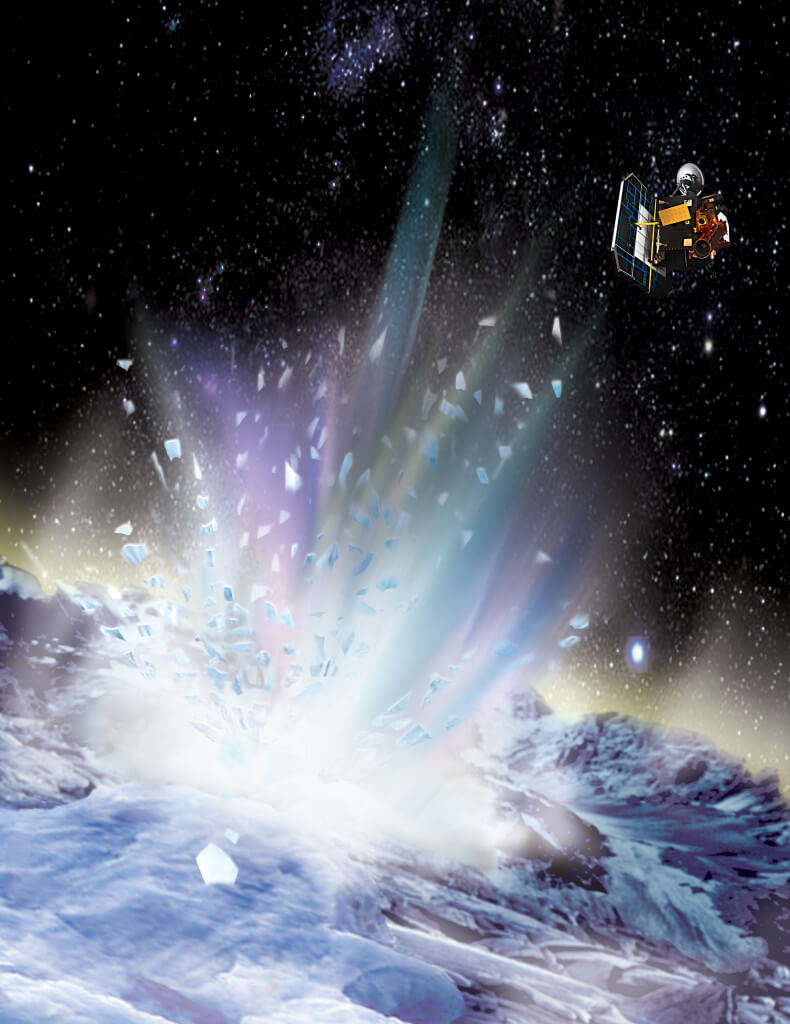The inception: Deep Impact being built at Ball Aerospace & Technologies Corporation in Boulder, Colo. Image courtesy of Ball Aerospace & Technologies Corp.
Deep Impact launched from Cape Canaveral, Fla., on Jan. 12, 2005. Image courtesy of NASA.
An artist’s rendering of Deep Impact releasing the impactor toward the comet. Image courtesy of Ball Aerospace & Technologies Corp.; Modified By Tim Cline/UMD.
An artist’s rendering of the impactor crashing into the comet. Image courtesy of Ball Aerospace & Technologies Corp.
“It dramatically changed the way we look at comets,” says Maryland astronomer Michael A’Hearn, who led the mission. Data from Deep Impact proved, for instance, that many comets are mostly porous, as fluffy as a bank of powdered snow. After the first mission ended, Maryland scientists convinced NASA to keep using Deep Impact rather than let it spin off into space. Its later missions led to discoveries about comets’ chemical makeup, formation locations and surface changes. Photo by John T. Consoli/UMD
9P/Tempel, 67 seconds after it obliterated the impactor. The image was taken by the high-resolution camera; light from the collision saturated the camera’s detector, creating the bright splash seen here. The image reveals topographic features, including ridges, scalloped edges and possibly impact craters. Image courtesy of NASA / JPL-Caltech / UMD
These images show a before-and-after comparison of the area targeted by the impactor. The image on the left shows the comet surface just before the impactor hits; the arrow shows the direction of the impactor, and the spot shows the target. The image on the right shows the plume of material from the impact about 11 minutes later. Image courtesy of NASA / JPL-CALTECH / UMD
Using data from Deep Impact, NASA astronomers put together a “recipe” for a comet’s ingredients. The ingredients were excavated from 9P/Tempel when Deep Impact’s impactor hit its surface. Astronomers found evidence that the comet included clay, iron-containing compounds, carbonates (the minerals in seashells), crystallized silicates such as the green olivine minerals found on beaches, as well as polycyclic aromatic hydrocarbons, carbon-containing compounds found in car exhaust and on burnt toast. Deep Impact also found evidence of water vapor and carbon dioxide gas.
The ingredients pictured here are: (back, from left to right) a cup of ice and a cup of dry ice (in measuring cups, from left to right); olivine, clay, polycyclic aromatic hydrocarbons, spinel, metallic iron; (front, from left to right) the silicate enstatite, the carbonate dolomite, and the iron sulfide marcasite. Image courtesy of George Rossman of the California Institute of Technology | Credit: NASA / JPL-Caltech
This image, taken by Deep Impact, shows three ice-rich regions, with blue hues, located near cold regions of the comet. Image courtesy of NASA / UMD /SAIC
A composite image of 9P/Tempel, created by aligning a group of images taken by Deep Impact. Image courtesy of NASA / JPL / UMD
For the UMD team, the loss of the spacecraft was an emotional blow. “When something is taken away for good, you suddenly realize how much it’s been there,” says Professor Jessica Sunshine, who along with A’Hearn helped write the 1998 proposal that led to the mission. “We had a helluva run.” Photo by John T. Consoli/UMD












